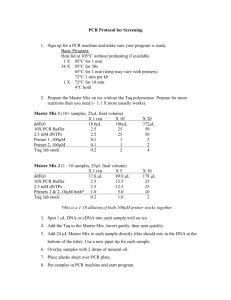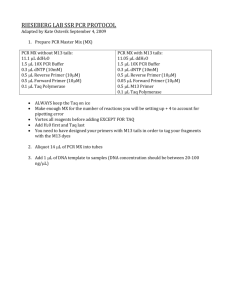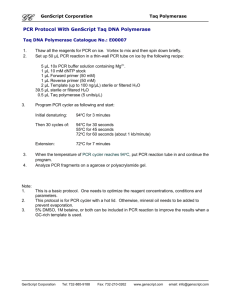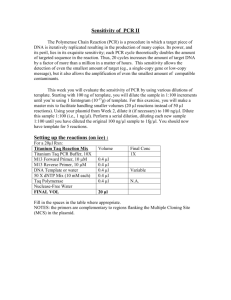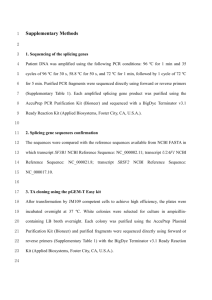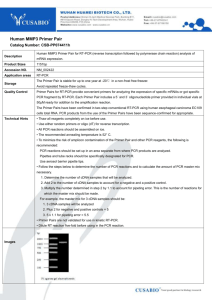SUPPLEMENTARY MATERIALS Mitochondrial DNA sequencing
advertisement
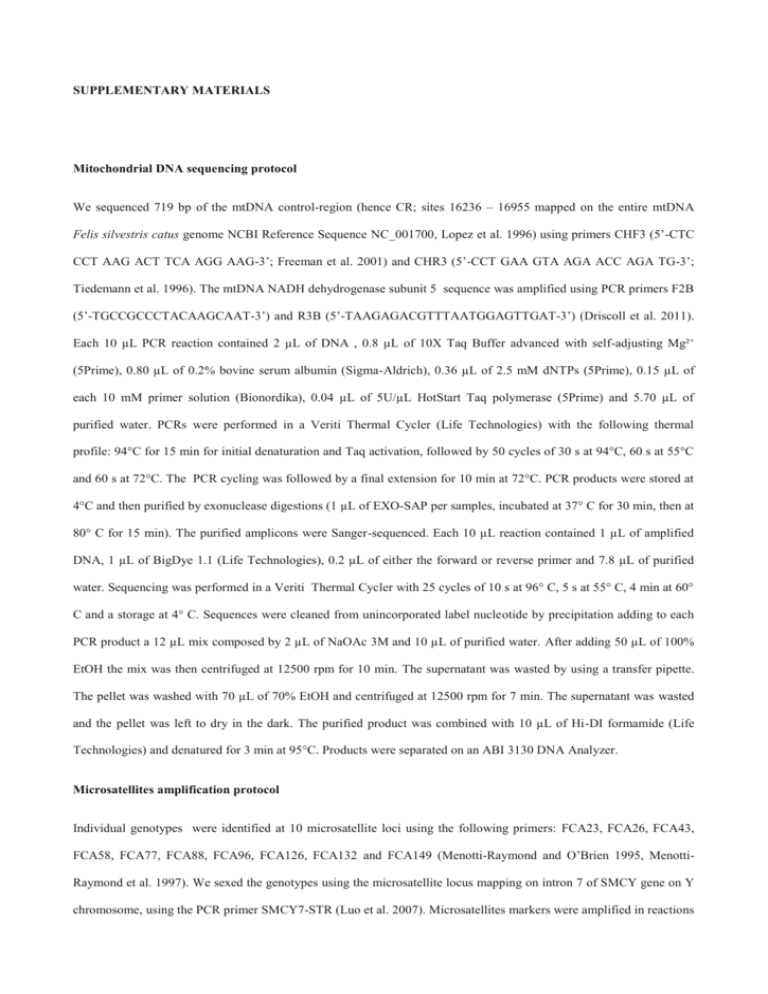
SUPPLEMENTARY MATERIALS Mitochondrial DNA sequencing protocol We sequenced 719 bp of the mtDNA control-region (hence CR; sites 16236 – 16955 mapped on the entire mtDNA Felis silvestris catus genome NCBI Reference Sequence NC_001700, Lopez et al. 1996) using primers CHF3 (5’-CTC CCT AAG ACT TCA AGG AAG-3’; Freeman et al. 2001) and CHR3 (5’-CCT GAA GTA AGA ACC AGA TG-3’; Tiedemann et al. 1996). The mtDNA NADH dehydrogenase subunit 5 sequence was amplified using PCR primers F2B (5’-TGCCGCCCTACAAGCAAT-3’) and R3B (5’-TAAGAGACGTTTAATGGAGTTGAT-3’) (Driscoll et al. 2011). Each 10 µL PCR reaction contained 2 µL of DNA , 0.8 µL of 10X Taq Buffer advanced with self-adjusting Mg²+ (5Prime), 0.80 µL of 0.2% bovine serum albumin (Sigma-Aldrich), 0.36 µL of 2.5 mM dNTPs (5Prime), 0.15 µL of each 10 mM primer solution (Bionordika), 0.04 µL of 5U/µL HotStart Taq polymerase (5Prime) and 5.70 µL of purified water. PCRs were performed in a Veriti Thermal Cycler (Life Technologies) with the following thermal profile: 94°C for 15 min for initial denaturation and Taq activation, followed by 50 cycles of 30 s at 94°C, 60 s at 55°C and 60 s at 72°C. The PCR cycling was followed by a final extension for 10 min at 72°C. PCR products were stored at 4°C and then purified by exonuclease digestions (1 µL of EXO-SAP per samples, incubated at 37° C for 30 min, then at 80° C for 15 min). The purified amplicons were Sanger-sequenced. Each 10 µL reaction contained 1 µL of amplified DNA, 1 µL of BigDye 1.1 (Life Technologies), 0.2 µL of either the forward or reverse primer and 7.8 µL of purified water. Sequencing was performed in a Veriti Thermal Cycler with 25 cycles of 10 s at 96° C, 5 s at 55° C, 4 min at 60° C and a storage at 4° C. Sequences were cleaned from unincorporated label nucleotide by precipitation adding to each PCR product a 12 µL mix composed by 2 µL of NaOAc 3M and 10 µL of purified water. After adding 50 µL of 100% EtOH the mix was then centrifuged at 12500 rpm for 10 min. The supernatant was wasted by using a transfer pipette. The pellet was washed with 70 µL of 70% EtOH and centrifuged at 12500 rpm for 7 min. The supernatant was wasted and the pellet was left to dry in the dark. The purified product was combined with 10 µL of Hi-DI formamide (Life Technologies) and denatured for 3 min at 95°C. Products were separated on an ABI 3130 DNA Analyzer. Microsatellites amplification protocol Individual genotypes were identified at 10 microsatellite loci using the following primers: FCA23, FCA26, FCA43, FCA58, FCA77, FCA88, FCA96, FCA126, FCA132 and FCA149 (Menotti-Raymond and O’Brien 1995, MenottiRaymond et al. 1997). We sexed the genotypes using the microsatellite locus mapping on intron 7 of SMCY gene on Y chromosome, using the PCR primer SMCY7-STR (Luo et al. 2007). Microsatellites markers were amplified in reactions of 8 µL of total volume containing: 0.8 µL of 10X Taq Buffer advanced with self-adjusting Mg²+ (5Prime), 0.80 µL of 0.2% bovine serum albumin (Sigma-Aldrich), 0.36 µL of 2.5 mM dNTPs (5Prime), 0.2 µL of of the 10 mM primer solution (Bionordika), 0.04 µL of 5U/µL Taq polymerase (5Prime) and 5.80 µL of purified water. PCRs were performed in a Veriti Thermal Cycler (Life Technologies) with the following thermal profile: 94°C for 2 min for initial denaturation and Taq activation, followed by 10 cycles of 40 s at 94°C, a touch-down step of 30 s from 60°C to55°C decreasing 1°C per cycle and 30 s at 72°C. The PCR cycling was followed by a final extension for 10 min at 72°C. PCR products were analysed in an ABI 3130 XL (Applied Biosystems) automated sequencer, and allele size was determined with GeneMapper 4.0 (Applied Biosystems).

